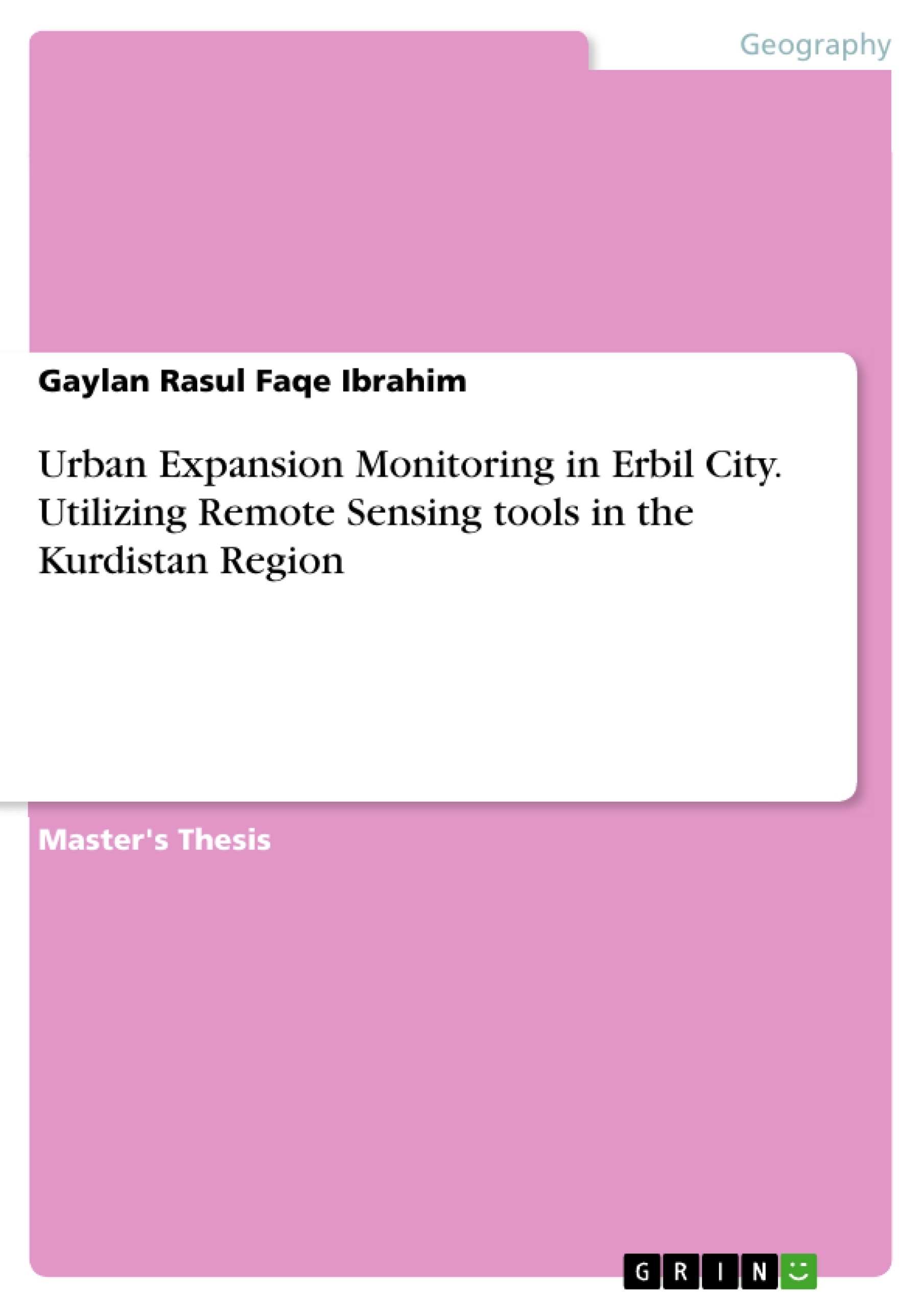Monitoring urban land use/cover changes provide spatio-temporal information on the pattern and the amount of the changes that has taken place across the land use/cover classes, and the information obtained from the urban expansion are valuable for sustainable planning and management of urban resources.
Remote sensing techniques provide fast and effective means for classifying and mapping urban land cove/use change through examining spectra characteristics of multi-dates satellite images. In recent years, Kurdistan region cities have witnessed a rapid growth of the urban rates due to previous socio-economic and political variations in the area. The purpose of the study is to analyse and visualize spatial pattern of urban land use changes in Erbil city-Kurdistan and to quantify the amount of variations in the land use classes by applying remote sensing approach.
The research examines multi-dates Landsat 5 TM imageries for 1987, 2000 and 2011 by using supervised classification of maximum Likelihood classifier to display and measure the changes in the land use/classes in ERDAS 9.1 imagine processing software. The accuracy of the overall classification was measured by using confusion metrics and Kappa coefficient to test overall accuracy classification. The study achieved an overall accuracy which rate from 95, 96.43 and 94.29 in 1987, 2000 and 2011 respectively, which indicates that the research has achieved a significant level of classes.
The outcome of the study revealed that the study area has remarkably experienced changes in its land use/cover during the period of the study as built up area was increased by (3975.66 to 6123.7 hectares) over in 1987 to 2000, and (6123.7 to 12755.1 hectares) in 2000 to 2011. On the other hand, the amount of other classes has greatly declined during the period of the study from. Evidence from the post classification analysis has shown that open land and vegetation classes have experienced the most significant changes of rates in the urban land during the period of the research. For example, the rate of changes from open land to urban land is (5084.46), whereas the rate of the vegetation that converted to urban land is (2130.69).
Inhaltsverzeichnis (Table of Contents)
- Abstract:
- Acknowledgments.
- Chapter one: Introduction.....
- 1.1: Introduction.
- 1.2: Significance of the study
- 1.3: Statement of the problem........
- 1.4: Aim of the study.
- 1.5: Research question........
- 1.6: Organization of the Thesis......
- Chapter two: Literature review
- 2.1: Introduction
- 2.2: History of application Remote Sensing.
- 2.3: Identifying urban land use change.……………………..
- 2.4: Urban change detection approach
- 2.5: Methods of digital image processing of satellite images…....
- 2.5.1: Image classification
- 2.5.2: Accuracy of image classification...
- Chapter three: Data and Methodology.
- 3.1: Introduction
- 3.2: Description of the Study area
- 3.3: Data used in this study.
- 3.4: Method.
- 3.5: Analysing Satellite images
- 3.5.1: Layer Stacking.
- 3.5.2: Subset of study site.
- 3.5.3: Choosing of appropriate band combinations
- 3.5.4: Image Pre-processing...
- 3.6: Image classification scheme...
- 3.7: Image classification.
- 3.7.1: Accuracy assessment
- 3.8: Change detection
- Chapter four: Result and discussion....
- 4.1: Introduction
- 4.2: Results
- 4.2.1: Image pre-processing..
- 4.2.2: Analysis of Supervised classification
- 4.2.3: Reclassification.
- 4.2.4:Post-classification change detection techniques .......
- 4.2.5: Accuracy assessment
- 4.3: Discussion...
- 4.3.1: Image pre-processing and supervised classification..
- 4.3.2: Reclassification
- 4.3.3: Post-classification change detection
- 4.3.4: Accuracy assessment
- Chapter five: Conclusion and Recommendation.
- 5.1: Limitations of the research
- 5.2: Contributions of the research to the body of knowledge..
- 5.3: Conclusion.
- 5.4: Recommendations.
- References:
- Appendices.
- List of Figure:
- List of Table:
Zielsetzung und Themenschwerpunkte (Objectives and Key Themes)
This study aims to analyze and visualize the spatial patterns of urban land use changes in Erbil City, Kurdistan, using remote sensing techniques. It quantifies the variations in land use classes over time by examining multi-date Landsat 5 TM imagery. The research utilizes supervised classification and accuracy assessment methods to measure the extent of land cover changes and their implications for urban planning and resource management.
- Urban expansion and land use change in Erbil City, Kurdistan.
- Application of remote sensing and image processing techniques for land cover analysis.
- Spatial patterns and rates of change in urban land use classes.
- Assessment of the accuracy of classification and change detection results.
- Implications for urban planning and resource management.
Zusammenfassung der Kapitel (Chapter Summaries)
Chapter one introduces the study, outlining its significance, the research problem, the aim, research question, and the organization of the thesis. Chapter two delves into the literature review, exploring the historical application of remote sensing, identifying urban land use change, urban change detection approaches, and methods of digital image processing of satellite images including image classification and accuracy assessment. Chapter three focuses on the data and methodology, providing a description of the study area, the data used, and the methods employed. Chapter four presents the results and discussion, showcasing the image pre-processing, supervised classification, reclassification, post-classification change detection techniques, and accuracy assessment results. Finally, Chapter five concludes the study, highlighting limitations, contributions to the body of knowledge, and recommendations for future research.
Schlüsselwörter (Keywords)
This research focuses on urban land use change, remote sensing, image classification, change detection, accuracy assessment, urban planning, and resource management. It utilizes Landsat 5 TM imagery, supervised classification, maximum likelihood classifier, and confusion matrix techniques to analyze and quantify the spatial patterns of urban expansion in Erbil City, Kurdistan.
- Citation du texte
- Gaylan Rasul Faqe Ibrahim (Auteur), 2013, Urban Expansion Monitoring in Erbil City. Utilizing Remote Sensing tools in the Kurdistan Region, Munich, GRIN Verlag, https://www.grin.com/document/311575



